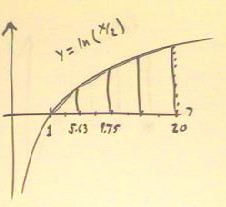
We will compare the left, right, and trapezoidal approximations and actual integral of y = ln(x/2).
- We conclude that the actual integral will always be greater than the trapezoidal approximation.
We proceed to calculate the values of the integral and of the n = 3 approximations for x = 2 to x = 11.
The same techniques will be used and the same ordering will be obtained for the original interval x = 2 to 20; you should complete these calculations.
- The DERIVE command vector ([log(x/2)], x, 2, 11, 3) will give a single-column listing of the values.
- The DERIVE command sum (vector ([log(x/2)], x, 2, 11, 3) ) will give a sum of these values.
- The DERIVE command 3 * sum (vector ([log(x/2)], x, 2, 8, 3) ) will give the left approximation.
- The DERIVE command 3 * sum (vector ([log(x/2)], x, 5, 11, 3) ) will give the right approximation.
- The DERIVE command 3 * sum (vector ([log(x/2) + log(x+3) / 2], x, 5, 8, 3) ) will give the trapezoidal approximation.
- The DERIVE command 3 * sum (vector ([log(x/2)], x, 3.5, 9.5, 3) ) would give the midpoint approximation.
The graph below depicts the values of the function at x = 2, 5, 8 and 11.
The 'left' altitudes will occur at x = 2, 5, and 8, and each will be multiplied by the 3-unit width of the corresponding interval to get the left approximation. The results are shown in the figure.
The 'right' altitudes will occur at x = 5, 8 and 11, and the results are shown.
The 'averages' of left and right altitudes, used for the trapezoidal approximation, are .46, 1.16 and 1.55; each is multiplied by the width of its interval to obtain the trapezoidal approximation, as indicated.
The integral is easily calculated using either integration by parts or a table.
We see that, as expected, the left approximation is the smallest, the right the largest, and the trapezoidal approximation is less than the actual integral.
The figure below shows why when a function is increasing the left approximation is low and the right is high.
Similarly if the function is decreasing we conclude that the right approximation is low and the left high.
The figure below shows how the error of the left approximation changes as the width of the interval is halved.
For a trapezoidal approximation, the error is the small 'crescent' between the top of the trapezoid and the actual curve.
The second derivative and the width of the interval determine how much the actual curve arcs above or below the trapezoid.